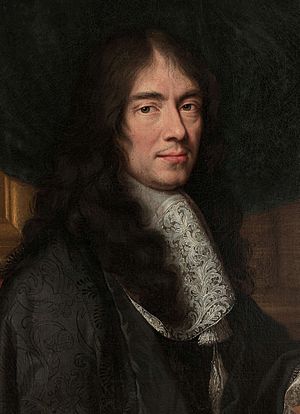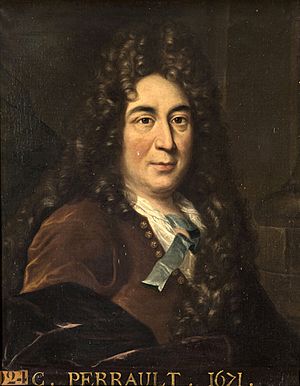Charles Perrault facts for kids
Quick facts for kids
Charles Perrault
|
|
|---|---|

Portrait (detail) by Charles Le Brun
|
|
| Born | 12 January 1628 Paris, France |
| Died | 16 May 1703 (aged 75) Paris, France |
| Occupation | Writer, author, member of the académie française |
| Genre | Fairy tale |
| Notable works | The Sleeping Beauty Little Red Riding Hood Cinderella Puss in Boots Bluebeard |
| Relatives | Pierre Perrault (brother) Claude Perrault (brother) Marie-Jeanne L'Héritier (niece) |
Charles Perrault (pronounced "perr-OH" or "puh-ROH"; born January 12, 1628 – died May 16, 1703) was a famous French writer. He is known for creating many of the fairy tales we know today. His stories were based on older folk tales. He published them in his 1697 book Histoires ou contes du temps passé (Stories or Tales from Past Times).
Some of his most famous tales include "Little Red Riding Hood", "Cinderella", "Puss in Boots", "Sleeping Beauty", and "Bluebeard". Perrault's versions of these stories later influenced the Brothers Grimm in Germany. His tales are still popular today and have been made into movies, plays, and more. Perrault was also an important person in French literature during the 1600s.
Contents
Life and Early Work
Charles Perrault was born in Paris, France, on January 12, 1628. He came from a wealthy family. He was the seventh child of Pierre Perrault and Paquette Le Clerc. Charles went to excellent schools and studied law. After his studies, he began a career in government service. He followed in the footsteps of his father and older brother.
In 1654, Charles moved in with his brother Pierre. Pierre had bought a job as the chief tax collector for Paris. Charles helped create the Academy of Sciences. He also helped restore the Academy of Painting.
Working for the King
In 1663, the Académie des Inscriptions et Belles-Lettres was started. Perrault became its secretary. He worked under Jean-Baptiste Colbert, who was the finance minister for King Louis XIV. Perrault used his influence to help his brother, Claude Perrault. In 1667, Claude was chosen to help design a new part of the Louvre palace. This part was built between 1667 and 1674.
Perrault wrote poems to honor the king and his artists. In 1668, he wrote La Peinture (Painting). This poem honored Charles Le Brun, the king's main painter. He also wrote Courses de tetes et de bague (Head and Ring Races) in 1670. This celebrated a big event held by King Louis XIV.
In 1671, Perrault was chosen to join the Académie française. This is a very important French group that focuses on the French language. He married Marie Guichon in 1672. She was 19 years old. Sadly, she died in 1678.
The Labyrinth of Versailles
In 1669, Perrault gave King Louis XIV an idea. He suggested adding 39 fountains to the gardens of Versailles. Each fountain would show one of Aesop's fables. The work on these fountains happened between 1672 and 1677. Water shot out from the animals' mouths, making it look like they were talking. Next to each fountain was a plaque with a short poem. Perrault wrote a guide book for this labyrinth, called Labyrinte de Versailles, in 1677.
A Big Debate
Perrault was part of a famous literary argument. It was called the "Quarrel of the Ancients and the Moderns". This debate was about whether old literature (from ancient Greece and Rome) was better than new literature (from Perrault's own time). Perrault was on the side of the "Moderns". He believed that the literature of his century was better.
He wrote Le Siècle de Louis le Grand (The Century of Louis the Great) in 1687. In this work, he argued that his time was better than ancient times. He even said that modern French literature was better than ancient works.
Later Life
In 1682, Perrault retired from his main job. He was 56 years old. The next year, Colbert, his boss, died. Perrault then stopped receiving his writer's pension. He also lost his other jobs.
After this, in 1686, Perrault decided to write epic poetry. He wrote Saint Paulin, évêque de Nôle (St. Paulinus, Bishop of Nola). Charles Perrault died in Paris on May 16, 1703, at age 75. On January 12, 2016, Google honored him with a special drawing showing characters from his fairy tales.
His Famous Fairy Tales

In 1695, when he was 67, Perrault decided to focus on his children. In 1697, he published his famous collection of stories. It was called Tales and Stories of the Past with Morals. It also had the subtitle Tales of Mother Goose. "Mother Goose" was a common phrase for popular storytelling at the time.
These tales were based on old European folk stories. They became very popular in France. Today, these short stories for children are the only works of his that are still widely read. Many people see him as the founder of the modern fairy tale genre. Other writers, like Madame d'Aulnoy, had written fairy tales before him. Madame d'Aulnoy even created the phrase "fairy tale."
Some of Perrault's popular stories are still told in a similar way today. These include "Cinderella" and "Sleeping Beauty". However, some stories have changed over time. For example, some versions of "Sleeping Beauty" today are partly based on a Brothers Grimm tale.
Perrault wrote "Little Red Riding Hood" as a warning. He wanted to tell readers to be careful of strangers. He ended his fairy tale with a moral lesson. It warned young girls about trusting men. He wrote, "Watch out if you haven’t learned that tame wolves / Are the most dangerous of all." Perrault warned about how some people can seem nice but are actually dangerous. In his version, Little Red Riding Hood gets into bed with the wolf and is eaten. This is different from the happy endings in most modern versions.
Perrault published his collection under his youngest son's name, Pierre Darmancourt. He probably did this because he was worried about criticism. In his tales, he used details from his own life. For example, the Chateau Ussé inspired "Sleeping Beauty". The Marquis of the Château d'Oiron was the model for the Marquis de Carabas in "Puss in Boots". He added details about fashion and society to his folk tales.
See also
 In Spanish: Charles Perrault para niños
In Spanish: Charles Perrault para niños
- Antoine Galland
- Alexander Afanasyev
- Brothers Grimm
- Charles Deulin
- Giambattista Basile
- Giovanni Francesco Straparola, often seen as the first to collect fairy tales
- Gustave Doré, who drew a famous picture of a wolf and young girl
- Hans Christian Andersen, who continued writing fairy tales later
- Madame d'Aulnoy
Images for kids


